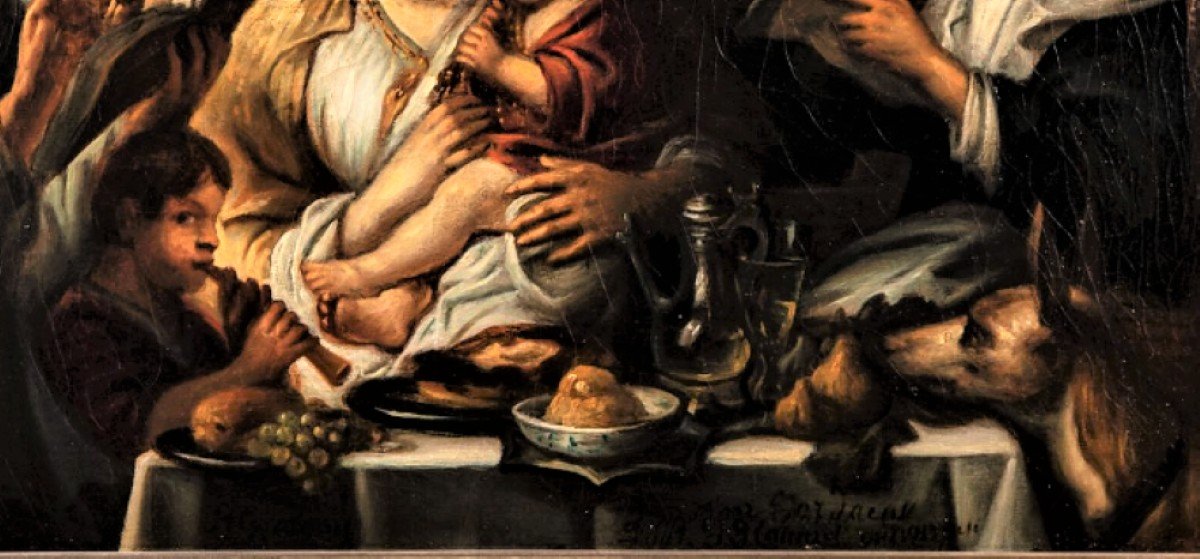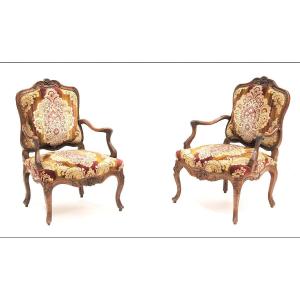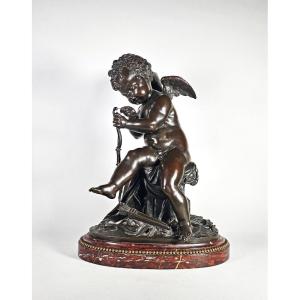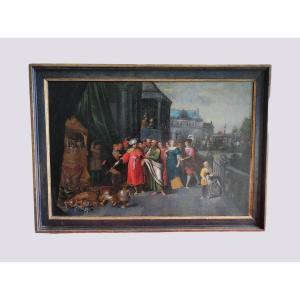"The Family Concert" - Jacob Jordaens (after) - XIXth Century After Jacob JORDAENS (1593-1678) -
The family concert As in the previous painting by this painter, "Ainsi chant les Vieux; les Jeunes..." presented and sold by our gallery Une Autre Epoque, this canvas presents a scene of a family reunion, with its colorful characters.
Oil on canvas
55 x 77 cm
Unlike the painting mentioned above, which was by Jordaens himself and came from a prestigious collection, this one is a reproduction executed in the 19th century of a work by the artist painted in 1638 and kept in the Museum voor Schone Kunsten of Antwerp
Jacob Jordaens (1593 - 1678) is a Flemish painter whose entire career took place in Antwerp. Very famous, he received orders from all over Europe. When Rubens (1640) and Van Dyck (1641) died, Jordaens was considered the first painter in his native town. A pupil of Adam Van Noort, he was received in 1615 as a master of the Antwerp guild as a tempera painter.
He very quickly acquired a personal style, but constantly returned to a few models of his elders, Rubens and Caravaggio in particular. Without ever having undertaken a trip to Italy, he finds in Caravaggism very close correspondences with his own sensibility: a harsh, vigorous realism, ample plump shapes and lighting that exalts bright colors. He also underwent the influence of Rubens, whose themes and compositions inspired him for a long time. His work always oscillated between these two tendencies. In Rubens' studio (1620 - 1640), Jordaens was more of a collaborator than a pupil of the master and worked alongside him for twenty years. He participated with Van Dyck in the great compositions that Rubens was then painting. In 1622, after Van Dyck's departure for Italy, he became Rubens' first assistant and probably took part in the elaboration of the twenty-one paintings commissioned for the Médicis gallery in Paris. A collaborator of Rubens, he nevertheless pursued his own career. He gradually reached his maturity and his style found its happiest expression during the 1630s. He succeeded in presenting each subject with great realism, in group portraits (particularly family) as in religious scenes. He moves from one genre to another in compositions that are often dense with sensual craftsmanship and blooming colours. It will draw until the end of its career in the subjects having ensured its success by proposing alternatives which will gradually lose in power. Seventeenth-century painting testifies, almost continuously, to a dynamic tension between the search for an ideal beauty and a fascinated, immediate apprehension of the proliferation of the spectacle of the world that is summarized under the unsatisfactory term of realism. The artists of the southern Netherlands, called "Spanish" claimed to achieve this ideal beauty whose imitation of the antique was supposed to offer the surest and best marked path. Nevertheless, most of them did not renounce nourishing their art in contact with reality, an incarnated, carnal reality, in particular under the Caravaggesque influence which swept over the Netherlands to become pregnant in the painting of a Jordaens in the end of the 1610s. The influence of Caravaggism, its use of deliberately rustic, plebeian typologies to embody history played a decisive role in Jordaens' choice of physiognomies that were sometimes violently "anti-classical" but nevertheless imbued with a nobility and singular authenticity (like the Abraham Grapheus model) when they embody characters from mythology or sacred history.












































 Le Magazine de PROANTIC
Le Magazine de PROANTIC TRÉSORS Magazine
TRÉSORS Magazine Rivista Artiquariato
Rivista Artiquariato